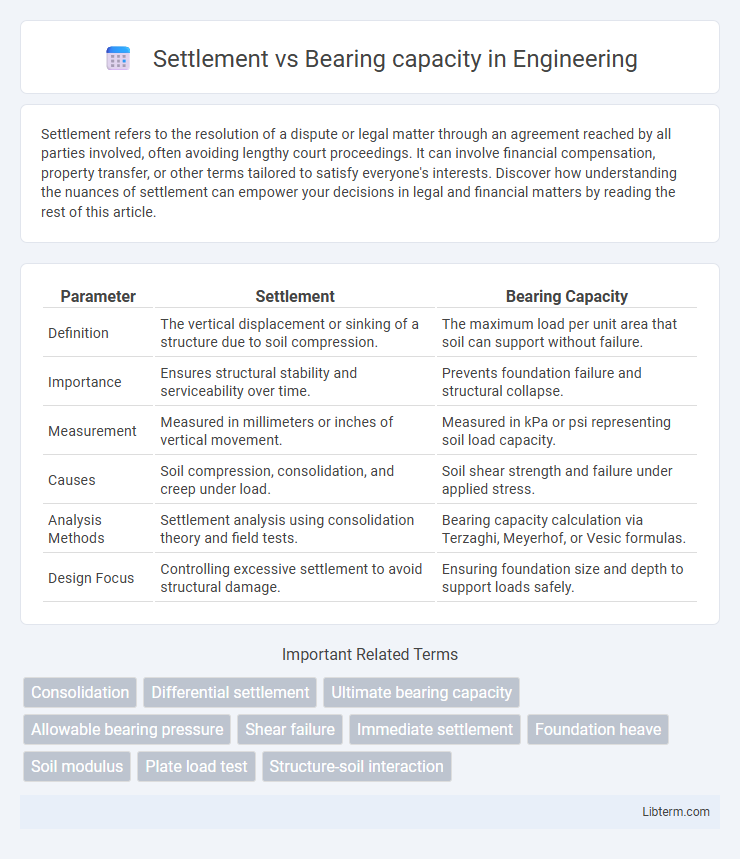Settlement refers to the resolution of a dispute or legal matter through an agreement reached by all parties involved, often avoiding lengthy court proceedings. It can involve financial compensation, property transfer, or other terms tailored to satisfy everyone's interests. Discover how understanding the nuances of settlement can empower your decisions in legal and financial matters by reading the rest of this article.
Table of Comparison
| Parameter | Settlement | Bearing Capacity |
|---|---|---|
| Definition | The vertical displacement or sinking of a structure due to soil compression. | The maximum load per unit area that soil can support without failure. |
| Importance | Ensures structural stability and serviceability over time. | Prevents foundation failure and structural collapse. |
| Measurement | Measured in millimeters or inches of vertical movement. | Measured in kPa or psi representing soil load capacity. |
| Causes | Soil compression, consolidation, and creep under load. | Soil shear strength and failure under applied stress. |
| Analysis Methods | Settlement analysis using consolidation theory and field tests. | Bearing capacity calculation via Terzaghi, Meyerhof, or Vesic formulas. |
| Design Focus | Controlling excessive settlement to avoid structural damage. | Ensuring foundation size and depth to support loads safely. |
Introduction to Settlement and Bearing Capacity
Settlement refers to the vertical displacement of the ground caused by the weight of a structure, which can lead to differential movement affecting structural integrity. Bearing capacity defines the maximum load per unit area that soil can support without experiencing shear failure or excessive settlement. Understanding both settlement and bearing capacity is critical for designing safe foundations that ensure stability and durability of buildings and infrastructure.
Definition of Settlement in Geotechnical Engineering
Settlement in geotechnical engineering refers to the vertical displacement or downward movement of a soil or foundation due to applied loads. It occurs when soil particles rearrange, compress, or expel water under stress, affecting structural integrity and serviceability. Understanding settlement is crucial for designing foundations with adequate bearing capacity to prevent excessive deformation and potential structural failure.
Understanding Bearing Capacity of Soil
Bearing capacity of soil refers to the maximum load per unit area the ground can support without undergoing shear failure or excessive settlement. It depends on soil properties such as cohesion, internal friction angle, density, and moisture content, and is essential for designing foundation systems to ensure structural stability. Accurate evaluation of bearing capacity helps prevent foundation failure and minimizes risks associated with uneven settlement or collapse.
Key Differences Between Settlement and Bearing Capacity
Settlement refers to the vertical displacement or sinking of a structure over time due to soil compression under load, while bearing capacity is the maximum load per unit area that the soil can safely support without failure. Settlement concerns the deformation and long-term stability of foundations, often measured in millimeters or inches, whereas bearing capacity deals with the soil's strength characteristics and is expressed in terms such as kPa or psf. Key differences include their focus--deformation versus strength--and their roles in foundation design to ensure both stability and serviceability of structures.
Factors Affecting Settlement in Foundations
Settlement in foundations is influenced by soil type, load intensity, and moisture content, which determines the degree of consolidation and compression under applied loads. Soil structure, including particle size distribution and void ratio, affects how much the soil compresses, directly impacting settlement magnitude. External factors such as groundwater fluctuations and the duration of applied loads also play critical roles in altering settlement behavior over time.
Factors Influencing Bearing Capacity of Soil
Soil bearing capacity is influenced by factors such as soil type, moisture content, density, and depth of the foundation. Cohesive soils have lower bearing capacity compared to granular soils due to their compressibility and shear strength characteristics. Additional influences include groundwater level, soil layer heterogeneity, and the presence of organic materials, which can significantly reduce the soil's load-bearing capacity.
Methods for Assessing Settlement
Settlement assessment methods include empirical formulas, field testing, and numerical analysis to predict soil compression under load. Plate load tests and consolidation tests measure settlement by applying controlled pressure and recording soil deformation over time. Advanced approaches like finite element modeling simulate soil behavior more accurately, optimizing design for safe bearing capacity and minimal settlement risk.
Techniques for Evaluating Bearing Capacity
Techniques for evaluating bearing capacity include field tests such as the Standard Penetration Test (SPT), Cone Penetration Test (CPT), and Plate Load Test, which provide direct measurements of soil resistance and deformation characteristics. Geotechnical engineers use these methods to estimate the maximum load a soil can support without failure, ensuring safe foundation design. Advanced numerical modeling and laboratory soil testing complement field data, enhancing the accuracy of bearing capacity assessments.
Effects of Improper Settlement and Bearing Capacity on Structures
Improper settlement can cause uneven support leading to cracks, tilting, and structural failure, while inadequate bearing capacity results in excessive deformation and foundation collapse. Both issues compromise the integrity and safety of structures by inducing differential settlements and overstressing foundation materials. Ensuring proper assessment of soil bearing capacity and controlled settlement is critical to maintaining structural stability and longevity.
Best Practices for Managing Settlement and Bearing Capacity
Effective management of settlement and bearing capacity involves thorough geotechnical site investigations to accurately assess soil properties and load-bearing potential. Implementing ground improvement techniques such as compaction, grouting, or the use of geosynthetics enhances soil strength and reduces settlement risks. Regular monitoring of foundation performance through settlement gauges and load tests ensures early detection of potential failures, allowing timely maintenance and design adjustments.
Settlement Infographic

 libterm.com
libterm.com